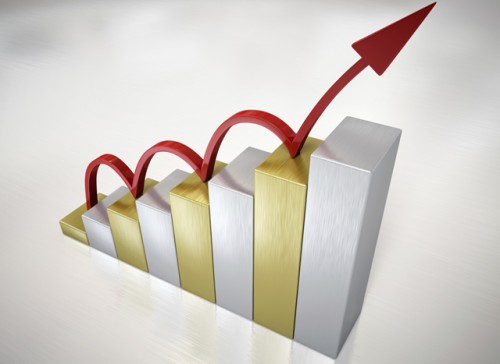Silver will cost more than gold !
 Between 1900 and 2010, world gold stocks have increased from 1 billion to 5 billion ounces. This is because the gold extracted from mines has scarcely been made use of, but instead has been hoarded in the form of ingots and jewellery. However, during the same period, silver reserves have fallen from 12 to 1 billion ounces because part of production has been consumed by industry without recycling taking place. (Amongst other purposes, silver is used for electrical microcircuits in cars, computers, mobile telephones, solar panels, etc.) In 1900, there was 12 times more silver than gold, whilst in 2010, there is 5 times less silver than gold. In view of the fact that it is 5 times rarer, silver has a higher intrinsic value than that of gold. Then, how is it that its current price is much lower than that of gold ?
Between 1900 and 2010, world gold stocks have increased from 1 billion to 5 billion ounces. This is because the gold extracted from mines has scarcely been made use of, but instead has been hoarded in the form of ingots and jewellery. However, during the same period, silver reserves have fallen from 12 to 1 billion ounces because part of production has been consumed by industry without recycling taking place. (Amongst other purposes, silver is used for electrical microcircuits in cars, computers, mobile telephones, solar panels, etc.) In 1900, there was 12 times more silver than gold, whilst in 2010, there is 5 times less silver than gold. In view of the fact that it is 5 times rarer, silver has a higher intrinsic value than that of gold. Then, how is it that its current price is much lower than that of gold ?
The price of silver is kept artificially low by a few American banks who sell on paper, metal which they do not own. If required, they draw from world reserves to meet the demands of physical delivery set out by particular investors. However, this reserve of physical metal is constantly dwindling because the requirements of industry are greater than mining output. The deficit is in the order of 150 million ounces per annum. There were 965 million ounces left at the start of 2010 (including a quantity held by people investing over the long term, which is thus unavailable for industrial consumption).
Consequently, available reserves will have been consumed by 2015. However, investors and above all, industrialists, will want to receive physical deliveries, but banks which are selling short will no longer be able to deliver. This will spell the end of their downward manipulation and the scarcity of silver will be dramatically exposed.
CONCLUSION: One ounce of gold costs $1400 (at the end of 2010); silver, which is five times rarer, should then be worth 5 x 1400 = $7000. The current price ($30) is 230 times cheaper than it should be. In any case, one can expect silver to reach at least parity with gold in the next few years. This is an outstanding opportunity to seize !
PRESIDENT OF THE UNITED STATES LYNDON B. JOHNSON conducted a financial analysis which corroborates our prognosis. In 1965, he perceptively observed that silver was getting rarer and that its price would rise accordingly. To cope with the situation, Johnson decided not to have any more coins struck in silver, and use government reserves to keep the price low. Here is his speech of the 23rd of July, 1965, in which he announces that silver coins were to be withdrawn from circulation.
“Now, all of you know these changes are necessary for a very simple reason: silver is a scarce material. Our uses of silver are growing as our population and our economy grows. The hard fact is that silver consumption is now more than double new silver production each year. So, in the face of this worldwide shortage of silver, and our rapidly growing need for coins, the only really prudent course was to reduce our dependence upon silver for making our coins. If we had not done so, we would have risked chronic coin shortages in the very near future. [...] If anybody has any idea of hoarding our silver coins, let me say this: treasury has a lot of silver on hand, and it can be, and it will be, used to keep the price of silver in line with its value in our present silver coin.”
In this way, the United States withdrew silver coinage from circulation; European states did likewise shortly afterwards. Coin was melted down and converted into ingots for investors and industrialists. As Johnson anticipated, this government measure did indeed delay the explosion in prices of that metal from the ʼSixties up to the present day. However, today, there is barely any coin to melt down and governments no longer have reserves of any significance. Now, there is nothing to stop prices spiralling upwards...
Author : EUPOROS SA®- © dépot légal 2011
Source : www.euporos.fr
Comments
No current comments
